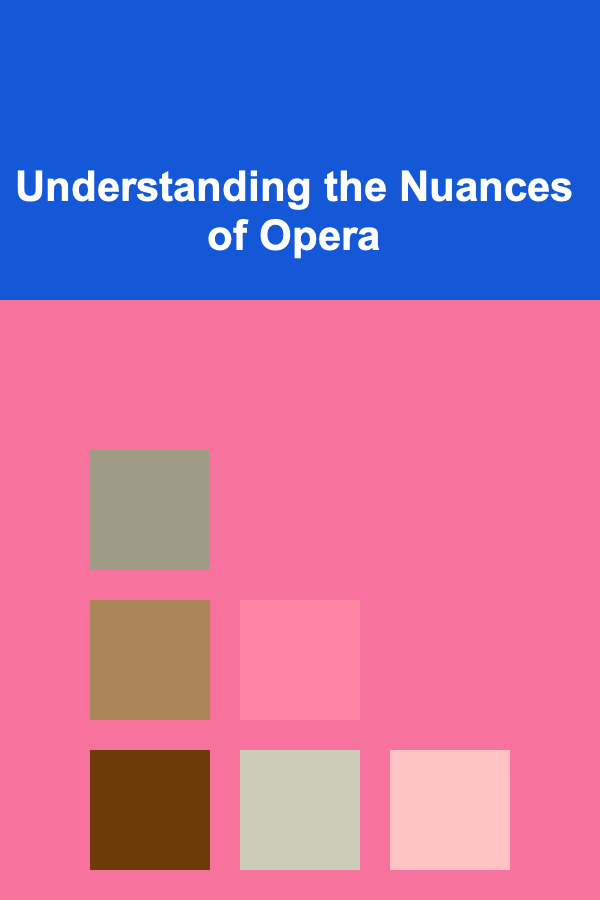
Understanding the Nuances of Opera
ebook include PDF & Audio bundle (Micro Guide)
$12.99$6.99
Limited Time Offer! Order within the next:

Opera, often perceived as an intimidating and elitist art form, is in reality a powerful and deeply moving synthesis of music, drama, literature, and visual arts. To truly appreciate opera, one must delve beyond the surface of elaborate costumes and soaring vocals and engage with the intricate layers of meaning embedded within its conventions. Understanding the nuances of opera is a journey, one that rewards patience and a willingness to explore its rich history, diverse styles, and complex artistic language.
Deconstructing the Myths and Misconceptions
Many misconceptions surround opera, preventing potential enthusiasts from fully embracing its potential. One common belief is that opera is solely for the wealthy and cultured. While ticket prices can be high for prestigious performances, community opera groups and streaming services have made opera more accessible than ever before. Another misconception is that opera is boring or overly long. While some operas are indeed lengthy, many others are concise and dramatically compelling. Furthermore, modern stagings often revitalize classic works, making them relatable and engaging for contemporary audiences.
Perhaps the most significant hurdle is the perception that opera is difficult to understand. The use of foreign languages, the stylized vocal techniques, and the historical settings can seem daunting. However, with a little preparation and a willingness to learn, these challenges can be overcome. Supertitles (projected translations above the stage) are now commonplace, allowing audiences to follow the plot even without fluency in the original language. Understanding the conventions of operatic vocal styles and the historical context in which the opera was created greatly enhances the viewing experience.
Essential Elements of Operatic Expression
To truly understand the nuances of opera, it's crucial to familiarize oneself with its core components:
The Libretto: The Foundation of the Drama
The libretto, or the text of the opera, is the foundation upon which the entire performance is built. It tells the story, develops the characters, and provides the emotional framework for the music. Librettos are often based on existing plays, novels, or historical events, but they are adapted and transformed to suit the needs of the operatic medium. A good libretto balances dramatic action with opportunities for musical expression, creating a compelling narrative that resonates with the audience.
Understanding the libretto requires careful attention to the language, the themes, and the characters' motivations. Pay close attention to the relationships between the characters and the conflicts that drive the plot. Knowing the source material, if there is one, can also provide valuable insights into the libretto's deeper meanings. For example, understanding Shakespeare's Othello before seeing Verdi's opera of the same name will provide context and enrich the experience.
Consider the opening scene of Puccini's La Bohème. The libretto immediately establishes the setting (a poverty-stricken garret in Paris), the characters (Rodolfo and Marcello, struggling artists), and their predicament (cold, hungry, and without money). The dialogue is witty and engaging, revealing the characters' personalities and their camaraderie. This concise exposition sets the stage for the drama to unfold.
The Music: The Language of Emotion
The music in opera is not merely an accompaniment to the drama; it is the drama. It conveys emotions, underscores relationships, and creates atmosphere. The composer uses a variety of musical techniques to achieve these effects, including melody, harmony, rhythm, and orchestration. Understanding the composer's choices is key to unlocking the emotional power of the opera.
Different composers have distinct musical styles. Verdi's music is known for its dramatic intensity and soaring melodies, while Wagner's music is characterized by its complex harmonies and use of leitmotifs (recurring musical themes associated with specific characters or ideas). Puccini's music is renowned for its lyrical beauty and emotional depth, while Mozart's music is celebrated for its elegance and wit. Familiarizing yourself with the styles of different composers will enhance your appreciation of their individual approaches to opera.
The aria, a solo song within the opera, is often the most memorable part of the performance. Arias allow the characters to express their innermost thoughts and feelings. Listen carefully to the melody, the harmony, and the vocal ornamentation. How does the music reflect the character's emotional state? Is the aria a lament, a declaration of love, or a cry for help?
Ensembles, such as duets, trios, and quartets, create dramatic tension and showcase the relationships between the characters. They often occur at moments of conflict or decision, allowing the audience to witness the interplay of emotions and motivations. The famous quartet in Rigoletto is a prime example of how ensemble singing can heighten the drama and reveal the complexities of the characters' relationships.
The orchestra plays a vital role in creating the atmosphere and underscoring the drama. Listen for the use of specific instruments to evoke particular emotions. For example, the strings might be used to create a sense of longing or tenderness, while the brass might be used to create a sense of power or triumph. The orchestra can also foreshadow events or remind the audience of past events through the use of leitmotifs.
The Voice: Instrument of Expression
The human voice is the primary instrument of operatic expression. Operatic singers undergo years of rigorous training to develop the vocal technique and stamina required to perform these demanding roles. Different voice types are suited to different roles, depending on their range, timbre, and vocal power. Understanding the different voice types and their characteristics is essential to appreciating the artistry of operatic singing.
The main voice categories are soprano, mezzo-soprano, alto (or contralto), tenor, baritone, and bass. Sopranos typically sing the roles of heroines and lovers, while mezzo-sopranos often sing the roles of supporting characters or older women. Tenors usually sing the roles of heroes and romantic leads, while baritones often sing the roles of villains or authority figures. Basses typically sing the roles of older men or figures of authority. However, these are general guidelines, and there are many exceptions.
Operatic singing requires a high degree of vocal control, agility, and breath support. Singers must be able to project their voices over the orchestra without the aid of amplification. They must also be able to sing with clarity, precision, and emotional expression. Pay attention to the singer's diction, phrasing, and vocal ornamentation. How does the singer use their voice to convey the character's emotions and intentions?
Coloratura sopranos possess remarkable vocal agility, capable of singing rapid scales and intricate ornaments. Lyric sopranos have a warm and expressive tone, ideal for portraying romantic heroines. Dramatic sopranos possess powerful voices, suited for portraying strong and passionate characters. Similarly, tenors can be categorized as lyric, dramatic, or heldentenor (heroic tenor), each with its own distinct vocal characteristics.
Staging and Design: Visual Storytelling
The staging and design of an opera production contribute significantly to the overall impact of the performance. The set design, costumes, lighting, and choreography all work together to create a visual world that supports the drama and enhances the emotional experience. Modern opera productions often incorporate innovative staging techniques, such as multimedia projections and unconventional set designs, to create a more immersive and engaging experience for the audience.
The set design can evoke a particular time period, location, or emotional state. Costumes can reveal the characters' social status, personality, and motivations. Lighting can create mood and atmosphere, drawing the audience's attention to specific elements of the stage. Choreography can enhance the drama and express emotions that cannot be conveyed through words or music.
Consider the contrast between a traditional staging of Aida, with its elaborate sets and costumes depicting ancient Egypt, and a modern staging that might strip away the historical trappings and focus on the universal themes of love, betrayal, and political intrigue. Both approaches can be valid and effective, depending on the director's vision.
Navigating Different Operatic Styles and Genres
Opera is not a monolithic art form. Over its centuries-long history, it has evolved into a diverse range of styles and genres, each with its own distinct characteristics:
Opera Seria: The Reign of High Drama
Opera seria, or "serious opera," was the dominant operatic genre of the 18th century. It typically featured stories based on classical mythology or ancient history, with a focus on noble characters and heroic deeds. Opera seria was characterized by its elaborate vocal ornamentation, its strict adherence to dramatic conventions, and its emphasis on the virtuosity of the singers. Composers such as Handel and Gluck were masters of opera seria.
Arias in opera seria were often structured according to the da capo aria form (ABA), which allowed singers to showcase their vocal abilities and embellish the melody with elaborate ornaments during the repeat of the A section. The plots often revolved around themes of love, honor, and duty, with a clear distinction between good and evil characters.
Opera Buffa: Comedy and Social Commentary
Opera buffa, or "comic opera," emerged as a reaction against the formality and artificiality of opera seria. It featured stories about everyday people, with a focus on humor, satire, and social commentary. Opera buffa was characterized by its simpler melodies, its faster tempos, and its more naturalistic style of acting. Composers such as Mozart and Rossini excelled in opera buffa.
Opera buffa often included stock characters such as the cunning servant, the foolish old man, and the young lovers. The plots often involved mistaken identities, disguises, and romantic intrigues. The music was often more accessible and memorable than that of opera seria, with catchy tunes and lively ensembles.
Romantic Opera: Passion and Grandeur
Romantic opera, which flourished in the 19th century, embraced themes of passion, heroism, and the supernatural. Composers such as Verdi, Wagner, and Puccini created operas that were both dramatically intense and musically opulent. Romantic opera was characterized by its soaring melodies, its lush harmonies, and its dramatic use of orchestration.
Romantic opera often explored themes of love, death, and redemption. The characters were often larger than life, driven by powerful emotions and tragic destinies. The music was often more expressive and personal than that of earlier operatic styles, reflecting the Romantic era's emphasis on individual emotion and experience.
Wagner's operas, such as The Ring Cycle, are particularly notable for their length, their complex symbolism, and their use of leitmotifs. Verdi's operas, such as La Traviata and Aida, are known for their dramatic intensity and their memorable melodies. Puccini's operas, such as La Bohème and Tosca, are celebrated for their lyrical beauty and their emotional depth.
Verismo Opera: Realism and Raw Emotion
Verismo opera, which emerged in the late 19th century, sought to portray real-life situations and emotions with unflinching honesty. Verismo operas often featured stories about working-class people and their struggles with poverty, violence, and social injustice. Composers such as Mascagni and Leoncavallo were key figures in the verismo movement.
Verismo operas were characterized by their gritty realism, their passionate vocal writing, and their dramatic use of orchestral color. The plots often revolved around themes of jealousy, betrayal, and revenge. The characters were often flawed and complex, reflecting the realities of human nature.
Mascagni's Cavalleria Rusticana and Leoncavallo's Pagliacci are two of the most famous examples of verismo opera. These operas are known for their intense emotional power and their unforgettable melodies.
Contemporary Opera: Experimentation and Innovation
Contemporary opera continues to evolve and experiment, pushing the boundaries of the art form in new and exciting ways. Contemporary opera composers often incorporate elements of other musical genres, such as jazz, rock, and electronic music, into their scores. They also explore new dramatic themes and staging techniques, reflecting the changing social and political landscape.
Contemporary operas often deal with complex and challenging issues, such as environmental degradation, social inequality, and the impact of technology on human relationships. The music can be dissonant, experimental, and challenging, but it can also be deeply moving and thought-provoking. Contemporary opera productions often incorporate multimedia elements, such as video projections and interactive technology, to create a more immersive and engaging experience for the audience.
Tips for Deepening Your Appreciation of Opera
Here are some practical tips for deepening your understanding and appreciation of opera:
- Do your homework: Before attending a performance, read the libretto and listen to recordings of the opera. Familiarize yourself with the plot, the characters, and the music.
- Read program notes: Program notes often provide valuable insights into the opera's history, context, and themes. They may also include biographical information about the composer, the librettist, and the performers.
- Watch the supertitles: Don't be afraid to rely on the supertitles to follow the plot. Even if you understand the language being sung, the supertitles can help you to catch nuances and details that you might otherwise miss.
- Focus on the music: Pay attention to the melody, the harmony, the rhythm, and the orchestration. How does the music contribute to the drama and express the characters' emotions?
- Listen to different recordings: Different recordings of the same opera can offer different interpretations of the music and the characters. Experiment with different recordings to find the ones that resonate with you the most.
- Attend pre-performance lectures: Many opera companies offer pre-performance lectures that provide background information about the opera and its context. These lectures can be a valuable resource for deepening your understanding and appreciation of the work.
- Join an opera club: Joining an opera club can provide you with the opportunity to discuss operas with other enthusiasts and learn from their insights and perspectives.
- Explore different opera styles: Don't limit yourself to one particular opera style or composer. Explore the diverse range of operatic genres and discover the ones that appeal to you the most.
- Consider the staging: Think about how the staging choices enhance or detract from the story. How does the visual aspect of the production affect your interpretation of the work?
- Embrace the experience: Allow yourself to be transported by the music, the drama, and the spectacle. Opera is an immersive art form, and the more you engage with it, the more you will get out of it.
Conclusion
Understanding the nuances of opera is a lifelong journey, but one that is richly rewarding. By familiarizing yourself with the essential elements of operatic expression, exploring different operatic styles and genres, and embracing the immersive nature of the art form, you can unlock the profound beauty and emotional power of opera. Don't be afraid to approach opera with curiosity and an open mind. The more you learn, the more you will appreciate its complexity, its artistry, and its enduring appeal. Opera offers a unique and powerful way to experience the human condition, and it has the potential to move, inspire, and transform audiences of all ages and backgrounds. So, embrace the challenge, and discover the magic of opera for yourself.

How to Create a Checklist for Website Security Optimization
Read More
How to Find Budget-Friendly Home Insurance Without Cutting Corners
Read More
How to Store Emergency Kits for Easy Accessibility
Read More
How to Use a Filing System for Easy Music Retrieval
Read More
How to Reduce Chemical Use for Wildlife Safety
Read More
10 Tips for Eco-Friendly Landscape Lighting
Read MoreOther Products

How to Create a Checklist for Website Security Optimization
Read More
How to Find Budget-Friendly Home Insurance Without Cutting Corners
Read More
How to Store Emergency Kits for Easy Accessibility
Read More
How to Use a Filing System for Easy Music Retrieval
Read More
How to Reduce Chemical Use for Wildlife Safety
Read More